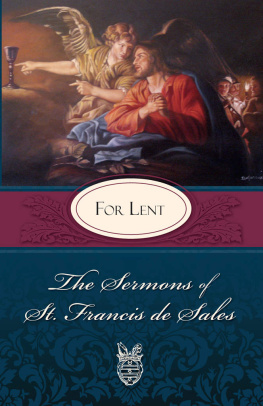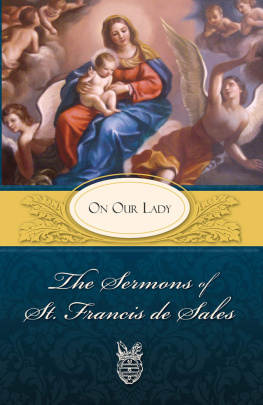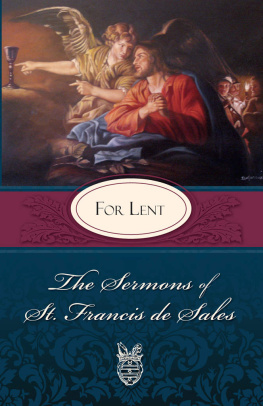The Sermons of
St. Francis De Sales
For Lent
Volume III in
the Series
St. Francis de Sales
| Nihil Obstat: | Rev. Msgr. John H. Dewson Censor Librorum |
| Imprimatur: |  Most Rev. Robert E. Mulvee Bishop of Wilmington Wilmington, Delaware December 12, 1986 Most Rev. Robert E. Mulvee Bishop of Wilmington Wilmington, Delaware December 12, 1986
Feast of St. Jane Frances de Chantal |
Copyright 1987 by the Visitation Monastery of Frederick, MD, Inc.
Library of Congress Catalog Card Number: 87-50084
Cover design by Milo Persic, .
Back cover image courtesy of DeSales Resources and Ministries, Inc., Stella Niagara, NY.
All rights reserved. No part of this book may be reproduced or transmitted in any form or by any means, electronic or mechanical, including photocopying, recording, or by any information storage or retrieval system, without permission in writing from the publisher.
TAN Books
Charlotte, North Carolina
www.TANBooks.com
1987
My advice is that henceforth
we live no more in ourselves, but that
in heart, intention, and confidence
we lodge forever
in the pierced side of the Saviour.
St. Francis de Sales The Sermons of St. Francis de Sales
| Volume I | On Prayer |
| Volume II | On Our Lady |
| Volume III | For Lent |

St. Francis de Sales 1567-1622
Bishop, Founder of the Visitation,
and Doctor of the Church
TABLE OF CONTENTS
ABOUT ST. FRANCIS DE SALES
St. Francis de Sales, the holy bishop, founder, and Doctor of the Church, is known throughout the Church for his great sanctity, learning, theological knowledge, gentleness, and understanding of the human soul. Through these marvelous gifts he converted and guided innumerable souls to God during his own lifetime, and re-converted 70,000 from Calvinism. He continues to direct many souls through his spiritual writings and published sermons. Today St. Francis de Sales is known as one of the great figures of the Catholic Counter-Reformation and of the 17th-century rebirth of Catholic mystical life.
St. Francis was born in 1567 in the castle belonging to the de Sales family in Thorens, Savoy, located in what is now southeastern France. His mother, Francoise, was only 14 years old when Francis, her firstborn, came into the world. This maternity was a dangerous one, the labor was long and difficult, and it was marvelled that both mother and child did not die. It is most noteworthy that a month before the birth Francoise had consecrated her unborn child to Our Lord in the presence of the Holy Shroud, which at that time was kept in the Sainte Chapelle in Chambery, France.
Later, Francis was to have a great devotion to the Holy Shroud because his mother had been delivered much better than expected through her veneration of this holy relic. He considered the Shroud to be his country's shield and greatest relic. It was his favorite devotional picture, and he had numerous images of it painted, engraved and embroidered, placing them in his room, chapel, oratory, study, reception rooms and breviary. St. Francis de Sales wrote that his devotion to the Holy Shroud was due to the fact that "my mother, when I was still in her womb, dedicated me to Our Lord before this holy banner of salvation."
As he grew older, St. Francis de Sales studied literature, law, philosophy and theology in Paris and Padua. Upon finishing his studies, he received a doctorate in civil and canon law. Though he could have had a brilliant secular career, he set his soul on following the call of God to the priesthood, and was ordained in 1593 at the age of 26. He was consecrated Bishop of Geneva at age 35, and was to remain Bishop of Geneva for the remaining 20 years of his life. Some years after St. Francis de Sales took charge of Geneva, King Henry IV suggested to him the possibility of a transfer to a diocese with more worldly advantages; the saint replied in words that soon became famous all over Paris: "Sire, I have married a poor wife and I cannot desert her for a richer one."
Shortly after becoming a bishop, St. Francis met St. Jane Frances de Chantal, a widow; between these two saints there grew a deep spiritual friendship. St. Francis became the spiritual director of Jane Frances, and with her, he founded in 1610 the religious order of nuns known as the Order of the Visitation, or the Visitandines.
Both of these saints loved the Heart of Jesus, and conceived this Heart as the particular treasure confided to the nuns of the Visitation. It is most remarkable that 60 years before the great revelations of the Sacred Heart of Jesus to the Visitandine St. Margaret Mary Alacoque (1673-1675), St. Francis de Sales and St. Jane Frances de Chantal had very often spoken to their spiritual daughters of this sacred love. St. Francis de Sales stated that the Visitandines who followed the Rule would receive the privilege of bearing the title, "Daughters of the Sacred Heart of Jesus," and he gave to this institute, as coat-of-arms, the Heart of Jesus crowned with thorns. The religious wear this emblem emblazoned on their pectoral crosses.
Although devotion to the Heart of Jesus was at this time very little known, God was drawing these two souls to prepare the Visitation as a holy sanctuary to receive the famous revelations to come. Also, the annals of the Order show that several Visitandines had experienced spiritual attractions toward, and even mystical favors from, the Heart of Jesus. Then, years later, with His revelations to St. Margaret Mary at the Visitation of Paray-le-Monial, God called this order to share with the entire Church that precious gift which had been its own special portion.
Among St. Francis de Sales' private papers collected after his death by St. Jane Frances de Chantal, there are many striking references to the Visitation's special calling to dwell in the Heart of Jesus and to love and imitate the two special virtues of His Heart, meekness and humility. "Learn of Me that I am meek and humble of Heart." In his sermons, too, St. Francis makes reference to the Heart of our Saviour and to the sacred Wound in His side. With the wisdom of hindsight, the reader can see how God in His Providence had chosen St. Francis de Sales to be, as it were, His "precursor," a preparer of hearts in anticipation of the great forthcoming revelation of His own Divine Heart.
The saintly bishop has left a description of an occasion in 1613, the feast of the Holy Shroud, when he was invited to be one of the prelates who exposed the holy relic for the veneration of the faithful. (It had been moved to Turin, Italy in 1578.) In a letter to St. Jane Frances de Chantal, he wrote: "A year ago, about this hour of the day, I was at Turin, exhibiting the Holy Shroud in the midst of a great crowd. Several drops of sweat, falling from my face, dropped upon the Holy Shroud itself, and thereupon, within my heart, I uttered this prayer: 'O Saviour of my life, deign to mingle my unworthy sweat with Thine and infuse into my blood, my life, and my affections the merits of this sacred moisture.' My dear Mother, the Prince Cardinal was angered because my sweat fell upon the Holy Shroud, but it came into my mind to tell him that our Saviour was not so nicely sensitive, and that He only shed His own sweat and blood in order to mingle them with ours, so as to give them the price of eternal life. And so may our sighs be joined with His that they ascend before the Eternal Father like the smoke of fragrant incense."
As a spiritual director, St. Francis de Sales was for a time the confessor of Blessed Marie of the Incarnation (Madame Barbe Acarie). This saintly woman was a wife, mother of six children, Parisian hostess, mystic, and foundress of five Carmelite convents.
Next page








![Saint Francis de Sales [Sales - The Saint Francis de Sales Collection [15 Books]](/uploads/posts/book/266802/thumbs/saint-francis-de-sales-sales-the-saint-francis.jpg)


![Saint Francis de Sales - The Saint Francis de Sales Collection [15 Books]](/uploads/posts/book/161144/thumbs/saint-francis-de-sales-the-saint-francis-de-sales.jpg)
 Most Rev. Robert E. Mulvee Bishop of Wilmington Wilmington, Delaware December 12, 1986
Most Rev. Robert E. Mulvee Bishop of Wilmington Wilmington, Delaware December 12, 1986